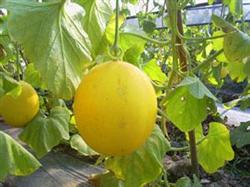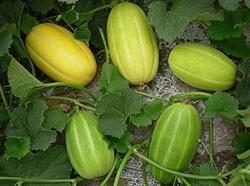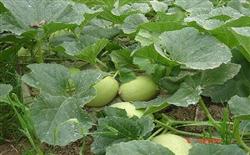Experience Exchange of Initial Melon Planting

In 2009, the price of Elizabeth melon was surprisingly good. The greenhouse was planted early and sold for 5 yuan per catty; the first crop melon in the arch shed sold for nearly 3 yuan per catty. Even the price of the second crop melon was similar to that of the first crop melon in previous years, about 1.5 yuan per catty. Therefore, many vegetable farmers have planted Elizabeth melon this spring, even some vegetable farmers who have not planted shed in previous years have joined the ranks of planting melon, Shouguang City rice field town South Korea village Han Shifu is one of them. In Han Shifu's shed interview, the reporter saw that the greenhouse melon has begun to pick. The first year of planting melon must have a lot of feelings, the reporter talked with him. "This melon is also on the market soon, I feel that one of the most wrong things to do this year is to plant too densely, planting 2500 trees per mu of land, although the number of trees planted is more, but the melon grows small, the quality is poor, and customers are unwilling to buy it." This time, I remember this lesson. You have to pay attention to what you say next year." Master Han said. Sentiment: a blind close planting melon quality is difficult to sell generally speaking, melon does not leave auxiliary vines, only stay the main vine words, one mu of land planting 2000 trees even dense. According to Master Han, he planted nearly 2500 trees per mu of land. The reporter saw that melons were smaller in his shed. Each of them was more than 2 jin. The 1.5 jin in his shed was even bigger. Observe plant growth, the reporter saw melon leaves big and thin, melon internodes longer. This crop of melon is planted in winter at low temperature. Why do plants grow too much nutrition? It is mainly caused by too dense planting. Melon planting too dense, melon branches and leaves block each other, lack of light, melon in order to compete for light, and desperately upward growth. In addition, under the same conditions, the photosynthetic products produced by plants are certain. If there are more photosynthetic products for the vegetative growth of stems and leaves, the nutrients used to produce fruits will naturally be less, and it is not surprising that fruits grow small. In addition, branches and leaves block each other, the function of leaves is reduced, the production of photosynthetic products is less, and it is difficult for fruits to grow. Therefore, we have always advocated reasonable density in newspapers, but not the more dense the better. Over-dense planting, yield can not be guaranteed, but the quality will certainly be very poor, the overall benefit is not high. Moreover, too dense planting will increase investment costs and increase labor intensity. Under normal circumstances, Elizabeth melon mu planting 1800-2000 trees is appropriate. "In winter and spring this year, there are many cloudy days, and it is difficult to plant melons, especially the small yellow spots that occur on the peel after cloudy days, which are very difficult to cure." In order to cure the disease, I increased the concentration of the pesticide and sprayed it a few times. I found that although the small yellow spots were cured, the melon in the shed had chemical damage, and I felt that the expansion speed of the melon was obviously slower." Master Han said. Sentiment 2: In fact, no matter what kind of vegetables are planted, the most afraid is even cloudy days, and this year around the Spring Festival even cloudy days more, many melons on the small yellow spots. The small yellow spots on the surface of melon are actually caused by bacterial diseases. "Before I planted melons, many people told me about the disease of small yellow spots on melons. If it is not prevented in time, it is likely to lead to reduced production. So before I planted melons, I had a fear of this disease, thinking, don't let me have this disease. The weather didn't help. This year, due to the weather, the melons in the shed had small yellow spots. After I discovered it, I didn't care about 37 or 21, so I seized the time to spray the medicine to prevent it. I increased the concentration of the pesticide. Although the small yellow spots were cured, the melons suffered from drug damage, and the fruit expansion slowed down." Master Han spoke of this and regretted it very much. No wonder Master Han's melons were planted together with his neighbor's. The others had all been sold out, but his had just begun to sell! So there was such an encounter. When it comes to small yellow spots, many vegetable farmers, like Master Han, are very afraid, because once the prevention and control is not in place, it will lead to reduced production. However, any disease should be mainly prevented, and it should be prevented in advance, which not only saves a lot of money to buy medicine, but also does not cause harm to plants. However, Master Han did not realize the importance of prevention. As a result, after the disease occurred, he increased the concentration of pesticide and sprayed it fiercely, resulting in phytotoxicity of melon in the shed. In fact, there is a physical method to prevent melon yellow spots, that is, bagging to solve, both to prevent small yellow spots, but also will not affect melon expansion. Melon from dipping flowers to melon button grow to goose egg big, at this time do not rush to melon bagging, because melon surface has a layer of dense fluff, if encounter even cloudy day shed humidity is larger, water droplets will only adhere to the fluff, will not stick to the melon skin surface, so melon is not easy to infect bacterial diseases, also will not form small yellow spots. However, with the continuous expansion of melon, especially in the period when melon grows to goose egg size of about one catty, melon skin villi gradually become thinner, if the humidity in the shed is larger, water droplets are easy to adhere to the surface of melon skin, resulting in increased probability of infection with bacterial diseases. During this period of time, if you know that there will be even cloudy days, before even cloudy days, you must put a bag on the melon, which greatly reduces the humidity of the melon surface and avoids the occurrence of small yellow spots. "This spring melon production is low, I said the largest melon is also 1.5 pounds, in addition to weather effects and planting too dense, there is another reason is that I did not leave auxiliary vines." At the beginning of planting, some vegetable farmers told me that it was good to keep auxiliary vines, and some vegetable farmers said that there was no need to keep auxiliary vines. If auxiliary vines were left, melon would be listed late. Yesterday, I heard from a relative in Changle that his melons weigh nearly three jin each. It seems that he will have to keep auxiliary vines in the future!" Master Han said. Feeling 3: For the early listing, the yield of melon is low. When the reporter interviewed in the countryside, he learned that there are not a few vegetable farmers who do not leave auxiliary vines like Master Han. The reason why they do this is to make melon appear on the market three or five days early, sell a high price, and at the same time facilitate management. But through the vegetable farmer practice knows: still stay auxiliary vine, melon yield is high. Because now vegetable farmers mostly leave a melon on a melon, the nutrition made by a main vine and the nutrition made by two vines are obviously different. Therefore, the reporter suggested: In order to ensure the yield of melon, the reporter suggested or stay auxiliary vine good. Selecting melon auxiliary vine itself is a delicate work, because whether melon auxiliary vine selection is successful determines whether melon growth is good. Therefore, we should be very careful in selecting auxiliary vines. So, how exactly should we choose the auxiliary vine? In the selection of auxiliary vines, generally do not choose the first and second root branches grown at the bottom of the plant, because although these two branches grow early, but it leaves dense, small, refused to jointing, delayed growth, weak growth potential, the production of nutrients is not enough to meet the needs of fruit growth. In addition, do not choose the fourth, fifth or more lateral branches, these lateral branches grow late, and when the number of leaves of the main vine reaches 14-15 leaves dipped in melon, these lateral branches have not grown long enough, the nutrition produced can not meet the needs of fruit growth, it is bound to affect the expansion of the fruit, delay the time to market. Therefore, in the selection of auxiliary vines, it is better to choose the third branch as auxiliary vines, because this branch grows fast, when melon dipped in melon, it has been able to accumulate sufficient nutrients to supply fruit growth, promote melon to grow big, grow fast, commodity good. "Through this season's planting, although there are some unsatisfactory places, but think about it carefully, I have also learned a lot of knowledge. Of course, these are all learned from the surrounding staff. This year, it feels good to use them in production. These experiences are all summed up by themselves." Master Han said. Sentiment 4: To solve melon partial melon needs to start from dipping melon partial melon, often visible, is melon side big side small, such melon can only be sold as broken, the price is lower. So, how to solve the problem of partial melon? Master Han told reporters that we should start with dipping melons to solve the problem. Generally speaking, melon partial melon in the dip flower within 7-10 days after the performance. Besides flower bud differentiation, plant growth and environmental factors, the uneven distribution of chemical solution during flower dipping was the main reason for partial melon. When dipping melon, because the female flowers tend to one side, the liquid medicine is easy to gather on the downward side of the female flowers after dipping, and the liquid medicine concentration is high, resulting in the expansion speed of one side of melon is obviously accelerated, while the expansion speed of the other side is slow, thus causing partial melon. So, how to solve the problem of partial melon when dipping melon? Master Han's method is to gently flick the liquid medicine with his finger after dipping the melon, so that the excess liquid medicine accumulated on the female flower can be flicked away, so that the uneven distribution of the liquid medicine will not occur, thus avoiding the occurrence of partial melon. Master Han reminded that if the above-mentioned method of playing melon is adopted, there are still melon partial melons in the shed. After partial melons occur, growth regulators can be used to adjust the newly appeared partial melons to accelerate the expansion of the slower growing side to make them normal melons. The specific operation is as follows: On the second day after the partial melon appears, use a bag of 5ml of sitting melon spirit mixed with 6 jin of water, and then use a small watering can to gently spray it at the middle of the slower growing side, as long as the melon body is evenly stained with a layer of liquid medicine, so that after 4-5 days, the partial melon can be adjusted to normal melon, but the liquid medicine cannot be sprayed too much, once used too much, it will cause the slower growing side to expand too fast, and it will also form partial melon or even cause the tumor of the melon body. Therefore, when spraying, we must pay attention to the concentration and amount of liquid medicine used.
- Prev

Cultivation techniques of muskmelon in open field in spring
The open field cultivation of muskmelon in spring has the advantages of low input cost and easy management, so it is the best choice for farmers to increase their income in a short time. Optional varieties such as Xiangmi 900, Sabai series and so on. The main results are as follows: 1. After soaking the seeds and selecting the varieties, the seeds can be dried properly in fine weather, and then screened. Soaking seeds in warm soup can be soaked in 55 degrees water for 1 minute.
- Next

Common physiological disorders of muskmelon
First, the causes of gourd-shaped fruit: 1. Sit melon too far, water and fertilizer conditions are poor, nutrient supply can not promote the fruit; 2. Plant nutrition growth is too prosperous, nutrients are running to the seedlings, melons are all gourd-shaped; 3. Low pollination quality, insufficient pollination, uneven pollination, many front-end seeds, base seeds.
Related
- Moge, come on! The staff of the peasant association in the producing area of cantaloupe were frightened when the crowd gathered.
- Causes and Solutions of low Fruit setting rate of Apple
- Symptoms and control measures of passion fruit virus disease
- Fruit growing lesson: how do apple orchards keep high yields?
- Can you build orchards in the mountains? What are the pros and cons?
- How to manage the coloring period of Crisson grape?
- This paper introduces the processing technology of two kinds of fig products.
- How much is a month for retired teachers in rural areas by 2020?
- How can strawberry planting increase sugar content? We should pay attention to management in many aspects.
- What are the cultivation techniques on how to improve the yield of golden fruit?

